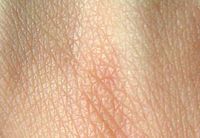
Photo from wikipedia
BACKGROUND Microcirculation is the flow of blood through the smallest vessels in the circulatory system. Capillaries respond to various pathologies much earlier than arteries and veins, the changes which indicate… Click to show full abstract
BACKGROUND Microcirculation is the flow of blood through the smallest vessels in the circulatory system. Capillaries respond to various pathologies much earlier than arteries and veins, the changes which indicate that the disease is already developing. Careful monitoring of the functioning of the capillary system often allows the detection of in vivo disorders at an early stage. AIMS The aim of the study was to evaluate the microcirculation within acne lesions. A noninvasive method of semi-quantitative blood perfusion measurement based on laser speckle contrast analysis (LASCA) and a quantitative assessment of the acne severity using the hyperspectral imaging method supported by image analysis and processing methods were used. PATIENTS/METHOD The acne lesion perfusion was compared to the healthy skin perfusion of the control group. The reflectance in the range from 400 to 1000 nm was also compared for acne lesions and healthy skin. A dedicated version of the algorithm based on the gray-level co-occurrence matrix was used to compare differences between acne lesions and healthy skin. RESULTS Blood perfusion in acne lesions is on average 117% higher than in healthy skin. The reflectance of acne lesions was lower in the range of 400-600 nm compared to the healthy skin. A statistically significant decrease in the reflectance of acne lesions was demonstrated for wavelengths: 434, 549, and 588 nm. CONCLUSIONS Increased blood perfusion in acne lesions compared to healthy skin suggests increased chemotaxis of inflammatory cells and wound healing. Decrease points in skin reflectance resemble the absorption peaks for hemoglobin and coproporphyrin III produced by Cutibacterium acnes. Thus, the proposed methods may serve not only for the early detection of acne lesions, before they manifest themselves clinically for the naked eye, but may also be a tool for quantifying the effectiveness of acne treatment.
Journal Title: Journal of cosmetic dermatology
Year Published: 2023
Link to full text (if available)
Share on Social Media: Sign Up to like & get
recommendations!